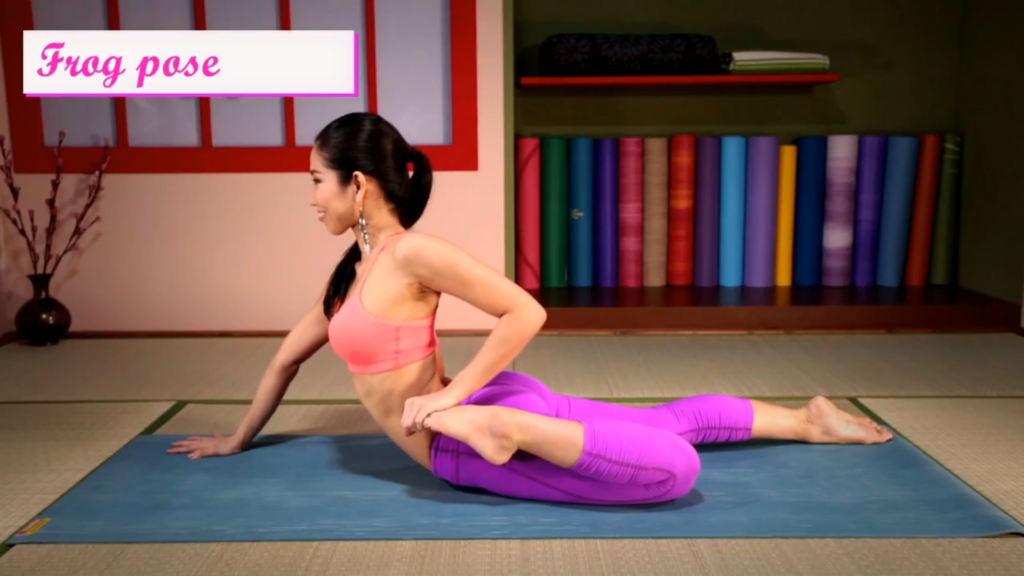
Exploring the One-Legged Frog Pose: A Journey to Balance and Inner Strength
Yoga is an ancient practice that has multiple mental, physical, and spiritual advantages. The One-Legged Frog Pose, or Eka Pada Bhekasana, is a powerful position in yoga that combines strength, flexibility, and balance. In this article, we will delve deeply into the One-Legged Frog Pose, analyzing its technique, advantages, and the significant impact it may have on your yoga practice.
The Technique One-Legged Frog Pose
To begin the One-Legged Frog Pose, start by lying down on your stomach in a flat position. You should bend your knees and bring your feet closer your buttocks while keeping the distance between your feet the same as your hip breadth.
Extend your right arm behind you and grasp hold of either your right foot or your right ankle.
After taking a few deep breaths, kick your right foot up towards the ceiling while simultaneously elevating your chest off the ground.
Exhale as you bring your chest back down to the ground.
Extend your left arm forward so that you can establish better balance and stability. After holding the stance for a few moments, gently release it, and then repeat the process on the opposite side.
Benefits of the One-Legged Frog Pose:
1. Opens the hip flexors: Eka Pada Bhekasana provides a deep stretch to the hip flexors, which can become tight due to prolonged sitting or physical activities. By opening the hips, this pose improves flexibility and mobility, promoting better posture and reducing lower back pain.
2. Strengthens the back and core: As you lift your chest off the ground, the One-Legged Frog Pose engages and strengthens the muscles in your back and core. This improves stability and posture, helping to alleviate discomfort and prevent injuries.
3. Enhances balance and coordination: Balancing on one leg challenges your stability and coordination. Regular practice of this pose can help improve your overall sense of balance, both physically and mentally.
4. Stimulates the digestive system: The compression of the abdomen in the One-Legged Frog Pose stimulates the digestive organs, promoting healthy digestion and aiding in detoxification. This pose can also help relieve bloating and constipation.
5. Cultivates focus and concentration: Balancing poses require mental focus and concentration. By practicing the One-Legged Frog Pose, you can enhance your ability to stay present, calm the mind, and improve overall mental clarity.
It is essential to move into the One-Legged Frog Pose with caution and to pay attention to what your body needs. Before attempting this asana, you should check in with an experienced yoga instructor or a licensed medical practitioner if you have any preexisting ailments or conditions. In addition, to guarantee that the procedure is risk-free, the following adjustments should be considered:
If it is difficult for you to reach your foot, you can use a strap or a towel to wrap it around your foot and then wrap your hand around the loop to grasp onto it.
If raising your chest off the ground feels like it will be too strenuous for you, you can begin by keeping your chest on the ground and concentrating on progressively increasing the lift over the course of time.
If you find it challenging to balance on one leg, you can practice this position close to a wall or use a yoga block as support until you feel more solid.
Concluding remarks:
The One-Legged Frog Pose is beneficial for a multitude of aspects, including the body, the mind, and the emotions. If you regularly practice yoga and include this pose in your routine, you may see improvements in your strength, flexibility, balance, and ability to concentrate. Always keep in mind that you should approach the posture with patience and attention, acknowledging the limits that your body places on you while progressively pushing yourself to your edge. Embrace the process of the One-Legged Frog Pose, and you will be able to experience the transforming force that it can bring to your entire health.
Yoga asanas are physical postures or poses that are practiced in yoga to promote flexibility, strength, balance, and overall well-being.
Asana practice in yoga has been shown to have a number of health advantages, including increased range of motion, increased muscular strength and tone, improved posture, increased blood flow, decreased levels of stress, and enhanced mental clarity.
The asanas of yoga can, in fact, be practiced by persons of any age or level of physical fitness. Each position has a variety of modified variations that can be tailored to the specific requirements and capabilities of the practitioner.
There are, in fact, a great number of yoga asanas that are suitable for beginners and that place an emphasis on developing fundamental strength, improving posture, and enhancing flexibility. There is the Mountain Pose (Tadasana), the Child’s Pose (Balasana), and the Corpse Pose (Savasana), as a few examples.
